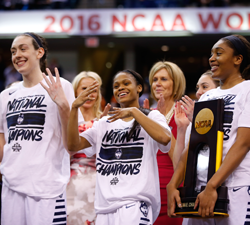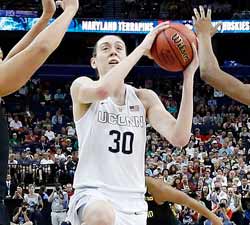Stewart, Fellow Seniors Write Another Chapter In UConn Lore

When it comes to winning championships and cultivating players that go on to achieve great success, there is currently no equal to the University of Connecticut women’s basketball program.
With UConn’s 82-51 win over Syracuse on Tuesday, the Huskies completed their sixth undefeated season, to win their unprecedented fourth straight NCAA title, and the 11th in the program’s storied history.
Photos: All-Access with Breanna Stewart & the UConn Huskies
UConn coach Geno Auriemma and his teams are a perfect 11-0 in championship games since winning their first title in 1995. That’s 11 championships in 21 years, a run of dominance few in the world of sports have ever achieved.
The timing of UConn’s rise to becoming the preeminent collegiate basketball program in the country aligns with the establishment and growth of the WNBA over the past two decades.
Through the first 19 drafts in WNBA history, only Tennessee has produced more overall draft picks than Connecticut, with UConn holding the edge in No. 1 picks. Since the NCAA Women’s Division I Basketball Tournament debuted in 1982, UConn (10) and Tennessee (8) have accounted for more than half of the tournament’s 34 national champions.
Most WNBA Draft Picks By School
- 36: Tennessee (2 No. 1 overall picks)
- 30: Connecticut (4 No. 1 overall picks)
- 24: Stanford (2 No. 1 overall picks)
- 20: Georgia
- 19: North Carolina, Duke (1 No. 1 overall pick)
No program has infused more current talent into the WNBA than Connecticut, with Auriemma essentially having a permanent front row seat to every WNBA Draft, including the upcoming 2016 WNBA Draft on April 14, where four-time Final Four Most Outstanding Player Breanna Stewart is the consensus No. 1 overall pick.
Most WNBA Players by College, Current Rosters
- 14: Connecticut
- 8: Duke
- 7: Tennessee, Rutgers
- 6: North Carolina
- 5: Maryland, Notre Dame, Stanford
- 4: LSU, Penn State, Texas A&M
- 3: Baylor, Cal Berkeley, Minnesota
There are more WNBA players hailing from Connecticut than any other school by a wide margin. UConn has also produced three players that have gone on to win WNBA Most Valuable Player honors – Diana Taurasi in 2009, Tina Charles in 2012 and Maya Moore in 2014. No other school matches that total, with two MVPs hailing from Tennessee (Candace Parker and Tamika Catchings) and two from USC (Lisa Leslie and Cynthia Cooper).
In the 2002 WNBA Draft, Connecticut produced three out of the top four picks (Sue Bird, Swin Cash and Asjha Jones) and could repeat that feat next week with Moriah Jefferson and Morgan Tuck expected to go high in the first round along with Stewart.

The three players are the first women’s basketball players to win four national championships in college and are part of a legacy of excellence out of Storrs, Connecticut.
“It is overwhelming to think about the amazing amount of sustained focus and work for this group over the past four years,” said Maya Moore, a two-time NCAA champion with UConn and a three-time WNBA champion with the Minnesota Lynx. “What makes us as alumni the proudest is seeing the program not only succeed but continue to get better. But this four-year run has truly been remarkable.”
When it comes to basketball dominance, Connecticut is in the same rare air as John Wooden’s UCLA teams in the 1960s and 70s and Red Auerbach’s Boston Celtics teams in the 1950s and 60s. While Phil Jackson leads all NBA coaches with 11 championships – equaling Auriemma’s total – he accomplished that mark with two separate franchises rather than a single program like the others.
Similar to Jackson’s championship teams, Auriemma has had some of the greatest players the women’s game has ever seen – Diana Taurasi, Maya Moore, Sue Bird, Rebecca Lobo, Swin Cash, Nykesha Sales and Tina Charles just to name a few. And, of course, Breanna Stewart’s name has to be included in that list.
“She’s impressive in every aspect of the game — her work ethic, her versatility, she’s able to do everything on the court extremely well,” said Stefanie Dolson, who won titles with Stewart in 2013 and 2014. “She hasn’t gotten complacent with where she is as a player and that’s something that I really respect about her game and about her as a person. It’s been nice to see it develop from how it was as a freshman to how it is now, how tough she’s become.”

But it’s not just about having the best players. It’s about having the best program with the best culture – to constantly push the program forward and not rest on your championship laurels.
“One of the things I love about Geno as a coach is how he casts such a great vision for how the game should be played” said Moore. “I remember seeing John Wooden books that he would read and feeling like we were a part of a long legacy of people who were passionate about playing the game in a beautiful way. At the end of the day, Coach wanted us to focus on how we played the game, and to get our satisfaction from the way we played together above anything else. That mindset makes it pretty hard to get complacent.”
The UConn women routinely put on a clinic of how the game of basketball should be played – they are unselfish, move the ball beautifully, make shots from all over the floor and can play suffocating defense on the other end of the court.
It truly remarkable to watch as new players are introduced to the program and adapt to the system in a way that appears seamless. Auriemma is getting top-tier talent every season, players that have been the standout star of their high school and AAU teams, that come in and conform to the goals of the program. UConn is not this successful simply because the talent of its roster is greater than that of their opponents, it is how these talented players come together and elevate their collective game to greater heights.
“Everyone makes it seem like that (it’s automatic),” said Jewell Loyd, the top pick in the 2015 WNBA Draft following her college career at UConn rival Notre Dame. “But to get every single person, even the bench players or the people who don’t play at all, to buy into system and buy into sacrifice and really leave it all on the floor every single night, that’s tough.
“The last six games of the season you have one bad game or you mess up on one possession, that could be the game. You see that on the men’s side with those crazy endings. To have that focus every single year, you have to give credit to Geno and his coach staff and then the players who come in ready every single year, knowing they have to make sacrifices – in their social life or whatever it is – to dedicate themselves to being great at basketball.”
With success comes disapproval and Auriemma and the UConn women have had to deal with critics that do not appreciate their success or the work that goes into becoming such a dominant force. Auriemma — who also coaches the equally dominant U.S. Women’s National Team — isn’t simply rolling a ball out on the floor and sitting back to watch his team win national title after national title.
“It’s hard to explain unless you’re in it or around it. The way coach Auriemma has taught us as players and has developed us as players – you’re constantly working hard, you’re never giving up, work ethic is the number one priority there,” said Dolson.
“[Coach Auriemma] does such a great job of knowing how to coach different players because no two players can be coached the same way and he knows how to get the best out of each one of his players. I think the best part was when I was a senior, I got to take a step back and watch him do that with the younger players. It’s just an amazing program to be a part of and I’ve definitely been honored to be a part of that.”

With another championship trophy now headed to Storrs, there are two questions that present themselves – what does the future hold for Stewart and where does her UConn squad rank among the program’s all-time best?
“I think she’ll definitely go through a transition process, I think everyone does, but with the talent that she has it probably won’t be long,” Dolson said of Stewart’s transition from UConn to the WNBA. “At the same time, she’s played with older girls her whole life, whether it’s USA basketball, she’s always been moved up so I think she’ll be ready and I’m excited to see how she does.”
“I think for Breanna it was never about if she was capable of doing something — if she could shoot, if she could dribble, if she could pass. If anything, it was, ‘Is she capable of doing it on a consistent basis?” Is she capable of doing against this level of competition, this person, that person?’ said Kaleena Mosqueda-Lewis, who played with Stewart for three years at UConn and is now with the Seattle Storm, who owns the top pick in the 2016 WNBA Draft.
“It’s all based on her mental ability more than anything, for her to believe she could do it against anyone and at any time. Being coached by Coach Auriemma and that coaching staff has allowed her to gain that mentality that no one can stop her; that she can do whatever she wants, whenever she feels like it. With the body type she has, with the skill level she has, she’s been able to crush every opponent in her way.”
All signs point to Mosqueda-Lewis not being an opponent of Stewart’s anytime soon as most everyone anticipates Stewart being selected by the Storm with the first pick in next week’s draft, where she will reunite with Mosqueda-Lewis and play with UConn legend Sue Bird.
“Of course we’ve spoken about it; she was my teammate at UConn for three years,” Mosqueda-Lewis said of becoming teammates with Stewart again.
“Any possibility of being on a team together again would be awesome for us. We both would really look forward to it, but we’ll look forward to see what happens. She would be a great addition to our team. We could use her,” she said with a laugh.
With Stewart’s college career now complete, her run at UConn will be remembered as one of the most special in the history of the game. While no other UConn team can tout her four consecutive championships, there will be plenty of arguments about where Stewart’s teams stack up against the great teams of UConn’s past.
“It’s hard to compare eras, I don’t think it can actually be done,” said Moore. “Each team had its own challenges, seen and unseen, and played at different times with different players, but the constant through all the teams is the culture that the coaches and players have committed to sustaining of excellent, team basketball.”
Of course, that’s a pretty good problem to have – to try to figure out which of your alma mater’s 11 championship teams was the best ever. Most teams would love to have those kinds of problems.
,xPosition=.5,yPosition=.5)
,xPosition=.5,yPosition=.5)
,xPosition=.5,yPosition=.5)
,xPosition=.5,yPosition=.5)